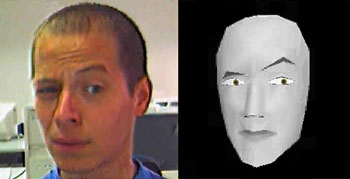
This issue in pdf Archive: Next issue: Next Special theme: |
|
|||
Modelling the 'Homunculus'by András Lórincz The Neural Information Processing Group of the Eötvös Loránd University Budapest has been engaged in researching reflexive systems, capable of collecting experiences, including reinforcement. The system can learn from experiences and can accept directions. The system envisioned will keep an eye on itself and may seem to know what it is doing. Generally speaking, the processing of signals that convey information can be considered as a transformation into another form that still carries the whole or just a piece of the original information. The environment feeds the system with some inputs and the system output represents (a part of) the environment. Whilst most models address the problem of coding inputs and making efficient internal representations, we are more concerned about the fundamental problem of making sense of these representations. In our view, the central issue of making sense or meaning is to provide answers to questions like "what does it mean?" in terms of our past experiences, or "how is it related?" in terms of known facts. In other words, making sense is inherently related to declarative memory. As a consequence, the homunculus (the little strange person who sits in the 'Cartesian theater' - to use the words of Dennett) becomes a central issue. There is a related fallacy that says that the internal representation is meaningless without an interpreter. This fallacy claims that all levels of abstraction require at least one further level to become the corresponding interpreter. Unfortunately, the interpretation - according to the fallacy - is just a new transformation and we are trapped in an endless regression. This problem could be more than a philosophical issue. We are afraid that any model of declarative memory or a model of structures playing a role in the formation of declarative memory could be questioned by the kind of arguments provided by the fallacy. In our theoretical efforts, we start by claiming that the paradox stems from vaguely described procedures of 'making sense'. The fallacy arises when we say that the internal representation should make sense. To the best of our knowledge, this formulation of the fallacy has not been questioned except in our previous work, where the fallacy was turned upside down by changing the roles: Not the internal representation but the input should make sense. The proposal is the following. The input makes sense if the same (or similar) inputs have been experienced before and if the input can be derived or regenerated by means of the internal representation. According to this approach the internal representation interprets the input by (re)constructing it.
The idea behind this approach is to keep the infinite regression, make it a converging regression and execute this regression in a finite architecture. The change of the roles gives rise to a reconstructing loop structure. The loop has two constituents; the top and the bottom. The top contains the internal representation. The representation generates the reconstructed input. The bottom computes the difference between the actual input and the reconstructed input. This difference, the reconstructed error, corrects the internal representation, and so on. This is a finite architecture with a converging, but - in principle - endless iteration. In turn, the infinite regression is transformed into a converging iteration, and a route has been opened to reduce the fallacy to the problems of stability and convergence. The approach - in principle - leads to a reflexive system, which can infer about the external world, about its own state and about the actual interaction between those. Notably, there are relatively strong (mathematical and computational) constraints on how such a reconstruction network should work. Constraints emerge, for example, from optimization of information transfer between bottom and top. Such constraints severely restrict modelling. We accepted these constraints and started to develop a model of the 'homunculus'. The uniqueness of our model is that starting from a relatively small set of hypotheses, many structural and functional features can be derived. These features are indirect predictions of the model. Without including biological constraints beforehand, we could show the emergence of some specific low order memory functions. The emerging properties of our model:
To give an example, consider novelty detection. Several works have shown that maximization of information transfer gives rise to sparse representation for natural stimuli. Then novel information (which could be a novel natural stimulus) gives rise to a non-sparse representation. In turn, the distribution of neural activities at the top indicates whether the actual input is familiar or novel: distinctions between novelty and familiarity can be immediate upon (the first) bottom-up information transfer in the loop. Link: Please contact: |
|||


